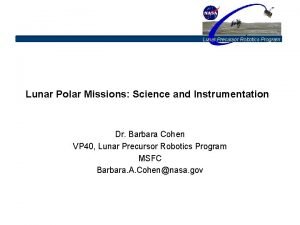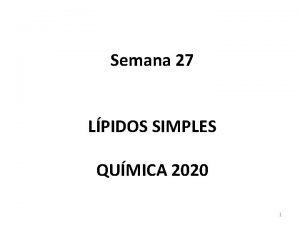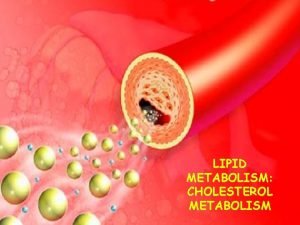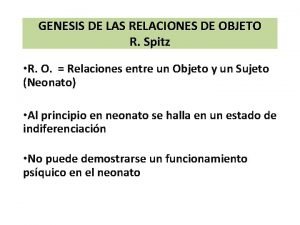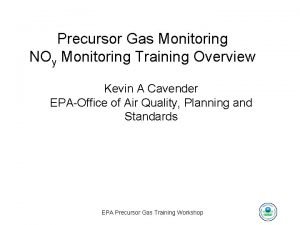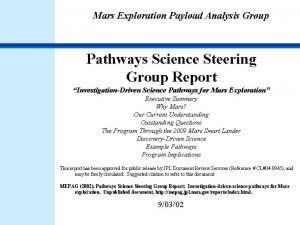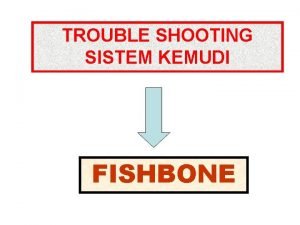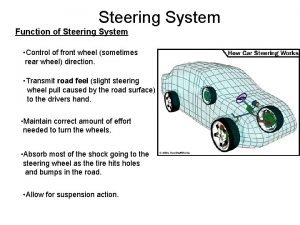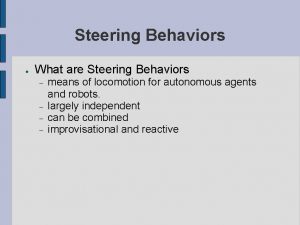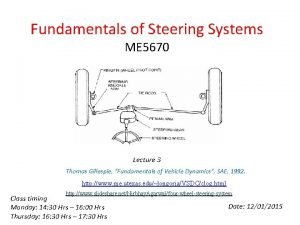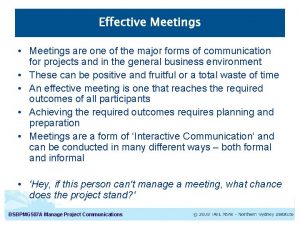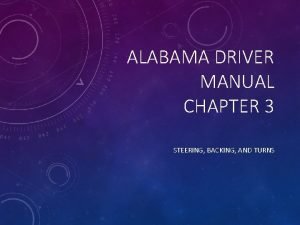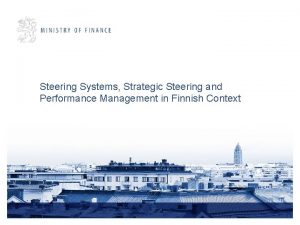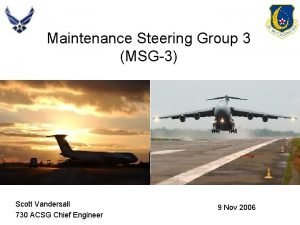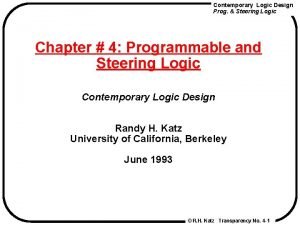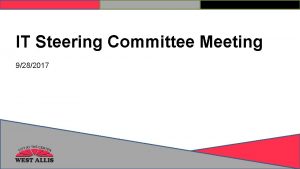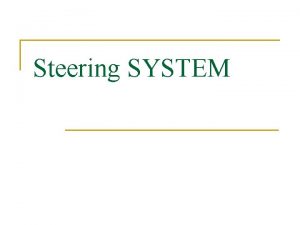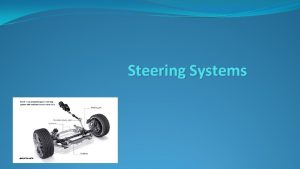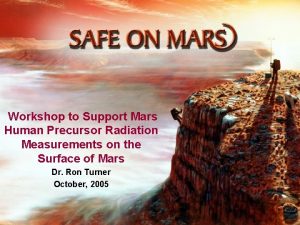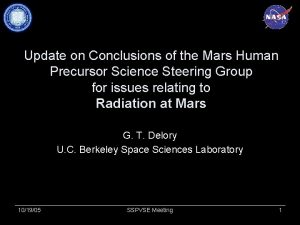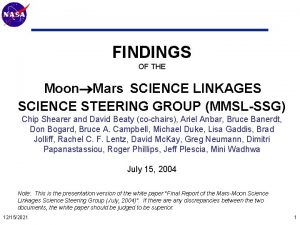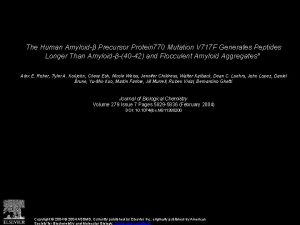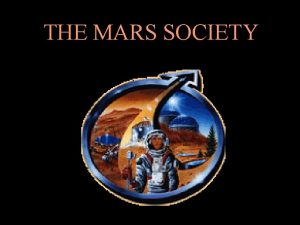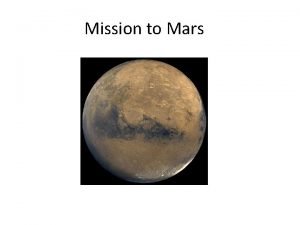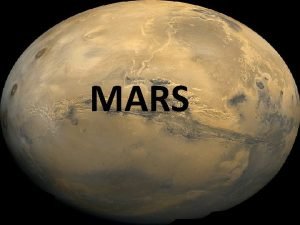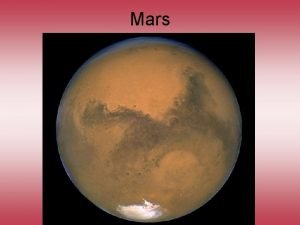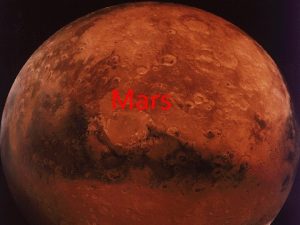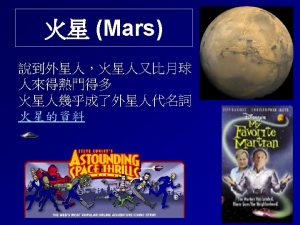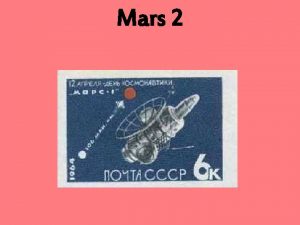Mars Technology Program MARS HUMAN PRECURSOR SCIENCEEXPLORATION STEERING
























![Team Atmosphere Example: Melnik and Parrot [1998] l l l l 2/17/2005 Simulated Martian Team Atmosphere Example: Melnik and Parrot [1998] l l l l 2/17/2005 Simulated Martian](https://slidetodoc.com/presentation_image_h2/1bf0573350b28ed36cbeee1170a8d77d/image-25.jpg)




















- Slides: 45

Mars Technology Program MARS HUMAN PRECURSOR SCIENCE/EXPLORATION STEERING GROUP (MHP-SSG) INTRODUCTION David Beaty, Noel Hinners Feb. 17, 2005 2/17/2005 1

MHP SSG Introduction The context A full program of preparing for a human mission to Mars needs to consider the following components: • Flight missions to Mars –Measurements of the martian environment. The full job –Tech. Demos/Infrastructure Emplacement This analysis • Missions to the Moon • Laboratory, Field, and Flight test program on Earth • Flight missions to Earth orbit 2/17/2005 Findings of the MHP SSG 2

MHP SSG Introduction Why do Precursor Missions? Reduce Risk • Uncertain knowledge of Mars—requires higher design margins than necessary • Demonstrate flight technology—flight-tested systems are less risky. Reduce Cost • Identify the cost drivers, find lower-cost alternatives Increase Performance From a starting point of minimum acceptable performance, are there ways performance can be increased at acceptable cost? 2/17/2005 Findings of the MHP SSG 3

MHP SSG Introduction Organization of the Study OVERALL LEADERS: Beaty, Hinners TECHNOLOGY/ INFRASTRUCTURE Hinners, Braun Transit Team Leader = Joosten Mars Atmosphere Flight Team HUMAN ACTIVITY AT MARS Beaty 2030 Science Focus Team Leaders = Bishop, Heldmann MEASUREMENTS Beaty, Snook Radiation Haz. Team Leader = Zeitlin Dust/Soil/ Toxicity/ Focus Team Leader = Wagner Biohazard/ PP Focus Team Leader = Allen Leader = Powell Atmosphere/ Weather Focus Team Surface Operations Team Leader = Farrell Leader = Kohlhasse Terrain Focus Team Leader = Eppler INPUTS TO ADVANCE MISSION PLANNING, (Frank Jordan) 2/17/2005 Findings of the MHP SSG Water Resources Focus Team Leader = XXX 4

MHP SSG Introduction Engaging the Community 2/17/2005 n = 100 Intellectual Diversity Organizational Diversity Geographic Diversity Findings of the MHP SSG 5

MHP SSG Introduction Assumptions for this Study 1. The first human mission is scheduled in 2030. • goes to the martian surface • at least one EVA 2. The series of robotic precursor missions will be designed to reduce risk/cost in the first human mission. For the purpose of this analysis the human program beyond the first mission is undefined. 3. Assume the long-stay and short-stay martian missions are BOTH under active consideration. 4. First dedicated robotic precursor mission in 2011. 2/17/2005 Findings of the MHP SSG 6

MHP SSG Introduction This Session 2/17/2005 Findings of the MHP SSG 7

Mars Technology Program MEASUREMENT SUB-TEAM INTRODUCTION David Beaty, Kelly Snook 2/17/2005 8

Measurement Team Introduction Risk Analysis 1. Risk analysis process guided by professional risk analysis team (SAIC). 2. Using expert focus teams, probability and consequence of risks that can be reduced by precursor measurement assessed. Risk Prioritization Criteria a) Magnitude of effect of precursor information on reduction of risk and/or cost of a human mission to Mars. b) Perceived degree of viability and cost of available engineering solutions c) Potential to obtain minimum necessary information in a less expensive way than by flying a mission to Mars. 2/17/2005 Findings of the MHP SSG 9

Measurement Team Introduction Risk Analysis All of the risks to the first human mission will need to be dealt with in one of the following ways: • • • Accept the risk Mitigate the risk by means of engineering solutions Buy down the risk by means purchasing advance information – – reduce uncertainty (so we don’t engineer to the upper limit) Establish new (lower-cost) engineering solutions It is not MHP SSG’s job to decide what risks are unacceptable. Our job is to place them in priority order to support future decision-making. 2/17/2005 Findings of the MHP SSG 10

Measurement Team Introduction Recommended Revision to Goal IVa 2/17/2005 Findings of the MHP SSG 11

Mars Technology Program TEAM DUST INTRODUCTION Sandy Wagner, Team Leader 2/17/2005 12

Team Dust Risks Risk 6 A: Failure Due to Abrasion and Accumulation Risk 6 B: Failure of Electrical Systems Risk 6 C: System Failure Due to Corrosive Effects of Dust Risk 7: If the crew inhales or ingests dust adverse health effects may result. Apollo 12 – Alan Bean’s Spacesuit After Before 2/17/2005 Findings of the MHP SSG 13

Team Dust Investigations and Measurements Investigation 1 A. Characterize the particulates that could be transported to mission surfaces through the air (including both natural aeolian dust and particulates that could be raised from the martian regolith by ground operations), and that could affect hardware’s engineering properties. Analytic fidelity sufficient to establish credible engineering simulation labs and/or performance prediction/design codes on Earth is required. 2/17/2005 Findings of the MHP SSG 14

Team Dust Investigations and Measurements a. Complete analysis • Shape and size distribution • Mineralogy • Electrical and thermal conductivity • Triboelectric and photoemission properties • Chemistry b. Polarity and magnitude of charge • individual dust particles suspended in atmosphere • concentration of free atmospheric ions with positive and negative polarities. c. The same measurements as in a) on a sample of airborne dust collected during a major dust storm. d. Subsets of the complete analysis described in a), and measured at different locations on Mars. 2/17/2005 Findings of the MHP SSG 15

Team Dust Investigations and Measurements Investigation #2. Determine the possible toxic effects of martian dust on humans. 2/17/2005 Findings of the MHP SSG 16

Team Dust Investigations and Measurements: 1. For at least one site, assay for chemicals with known toxic effect on humans. 2. Fully characterize: • soluble ion distributions • reactions that occur upon humidification • released volatiles 3. Analyze the shapes of martian dust grains 4. Determine if martian regolith elicits a toxic response in an animal species which is a surrogate for humans. 2/17/2005 Findings of the MHP SSG 17

Team Dust Risk Mapping Risk 6 A Risk 6 B Risk 6 C Risk Exposure Measurements Measurement 1 A. a For System Reliability Measurement 1 A. b For Electrical Shock Reduction Measurement 1 A. c For More Confidence in Measurements Measurement 1 A. d Less value than 1 A. a Measurement 2 A Risk 7 Measurement 2 B Measurement 2 C For Human Exposure Requirements Measurement 2 D 2/17/2005 Findings of the MHP SSG 18

Mars Technology Program TEAM ATMOSPHERE INTRODUCTION Bill Farrell, Team Leader 2/17/2005 19

Team Atmosphere Risks Risk #4: Wind shear and turbulence will create unexpected and uncompensatable trajectory anomalies affecting EDL and TAO. Risk #8: Dust storm electrification may cause arcing, and force human explorers to seek shelter during storms and affect TAO. Risk #10: During crew occupation and EVA, dust storm may affect visibility to the point where EVA’s for regular habitat maintenance becomes compromised. Risk #15: Photochemical and chemical reactions in the atmosphere have the potential to corrode equipment and/or create a toxic environment for humans. 2/17/2005 Findings of the MHP SSG 20

Team Atmosphere Investigations and Measurements Investigation #1 B. Determine the fluid variations from ground to >90 km that affect EDL and TAO including both fair-weather and dust storms. 2/17/2005 Findings of the MHP SSG 21

Team Atmosphere Investigations and Measurements – Measure v, P/ , and T in the atmosphere during EDL with as many profiles/locations as possible. Quantify turbulent layers. – Monitor surface/near-surface v, P/ , and T, as a function of time, as many locations as possible. – Make long-term observations of the weather from orbit (aeolian cloud frequency size and occurrence, temperature & density profiles, winds as a function of altitude, with profiles obtained globally). – During human EDL and TAO, pre-deploy ascent/descent probes to obtain P, V, and T along assumed trajectory. Measurements needed globally with special emphasis on 020 km to quantify boundary layer turbulence and 30 -60 km where vehicle dynamic pressures are large 2/17/2005 Findings of the MHP SSG 22

Team Atmosphere Example: BL Atmosphere Dynamics Temperature profile vs Local Time l l l Smith et al, 2004 Multi-sol composite 2/17/2005 Models indicate that boundary layer very dynamic and unstable in afternoon via solar heated surface MER Mini-TES obtained atmospheric temperature vs height profiles via radiative transfer inversion model Observed a super-adiabatic layer in the afternoon resulting in turbulent motion High time resolution shows the passage of thermal plumbs extending to high altitudes over MER… temperature changes on order of 5 o. C. What are the winds during unstable period? Don’t know because a surface MET package was not included Some of the plumbs may even be hotcored vortices [Ryan and Lucich, 1983] with substantial wind shifts Findings of the MHP SSG 23

Team Atmosphere Investigations and Measurements l Derive the basic measurements of atmospheric electricity that affects TAO and human occupation. – DC E-fields (electrostatic fields), AC E-fields (RF from discharges & RF contamination assessment), atmospheric conductivity probe, surface conductivity probe, and grain radius and charge – Combine with surface MET package to correlate electric and its causative meteorological source over a Martian year, both in dust devils and large dust storms. l 2/17/2005 Measurements needed on at least one landed mission. Findings of the MHP SSG 24
![Team Atmosphere Example Melnik and Parrot 1998 l l l l 2172005 Simulated Martian Team Atmosphere Example: Melnik and Parrot [1998] l l l l 2/17/2005 Simulated Martian](https://slidetodoc.com/presentation_image_h2/1bf0573350b28ed36cbeee1170a8d77d/image-25.jpg)
Team Atmosphere Example: Melnik and Parrot [1998] l l l l 2/17/2005 Simulated Martian dust cloud dynamics Charged grains via contact electrification Allowed large and small grains to separate via gravitational filtration Used Poisson solver to monitor ES fields Found inter-cloud potential differences of 300 k. V over 100 m dust devil and E-field values near local breakdown levels Rocket launch could cause a discharge from cloud top-to-bottom Parallel to KSC field mill system Findings of the MHP SSG 25

Team Atmosphere Investigations and Measurements l Determine the meteorological properties of dust storms at ground level that affect human occupation and EVA. – P (or ), V, T, and dust density (opacity) as a function of time at the surface, for at least a Martian year, to obtain an understanding of the possible MET hazards inside dust storms. Dust particle properties should be quantified (see Soil/Dust FT). – Orbiting weather station: optical and IR measurements to monitor the dust storm frequency, size and occurrence over a year, & measure terrain roughness and thermal inertia. Obtain temperature & density profiles, winds as a function of altitude, with profiles obtained globally. 2/17/2005 Findings of the MHP SSG 26

Mars Technology Program TEAM BIOHAZARD INTRODUCTION Carl Allen, Team Leader 2/17/2005 27

Team Biohazard Risks Risk #5: Martian life transported to Earth Hazards to Earth’s biota and ecosystems Risk #9: Terrestrial life transported to Mars Local / widespread contamination False positive indication of life on Mars Hybridization with Martian life Risk #11: Martian life released in surface habitat Health hazard to crew Potential for mixing ecologies Interference with biological life support systems 2/17/2005 Findings of the MHP SSG 28

Team Biohazard Investigations – High Risk Investigation #1 C. Determine if each Martian site to be visited by humans is free, to within acceptable risk standards, of replicating biohazards which may have adverse effects on humans and other terrestrial species. Sampling into the subsurface for this investigation must extend to the maximum depth to which the human mission may come into contact with uncontained Martian material. 2/17/2005 Findings of the MHP SSG 29

Team Biohazard Measurements Phase 1. Is life ‘everywhere’? l l Return and analyze samples in terrestrial laboratories. Test for evidence of Martian life in representative samples of the atmosphere, dust, near-surface soil, deep soil, rock and ice Fully characterize Martian life (if found) Test for biohazards Phase 2. Landing site screening l l l At the site of the planned first human landing, conduct biologic assays using in-situ methods Measurements and instruments specific to Martian life found by previous investigations 2/17/2005 Findings of the MHP SSG 30

Team Biohazard Investigations – High Risk Investigation #4. Determine the processes by which terrestrial microbial life, or its remains, is dispersed and/or destroyed on Mars, the rates and scale of these processes, and the potential impact on future scientific investigations. Measurements – Survival and reproduction under Martian conditions – Destruction or organics at the Martian surface – Mechanisms / rates of aeolian processes which disburse contaminants – Mechanisms of contaminant transport into the Martian subsurface – Adhesion characteristics of contaminants on landed mission elements 2/17/2005 Findings of the MHP SSG 31

Team Biohazard Measurements Simulated Mars Environments Test for survival and genetic adaptation of terrestrial life under Martian conditions Assess rates, scales and methods of contamination dispersal under Martian conditions 2/17/2005 Findings of the MHP SSG 32

Mars Technology Program TEAM RADIATION INTRODUCTION Cary Zeitlin, Team Leader 2/17/2005 33

Team Radiation Particles and Risks l Galactic Cosmic Rays (GCRs) – – – Continuous Low dose-rate Predictable Same at Earth and Mars Risk is to long-term health, “late effects, ” principally cancer. – Cannot be stopped by practical depths of shielding – Not stopped by Martian atmosphere – Include heavy ions which may be important biologically. l Solar Energetic Particles (SEPs) – – – Sporadic Sometimes v. high dose-rates Not predictable at present Not same at Earth and Mars Can present risk of immediate and severe illness, even death. – Can be stopped by practical depths of shielding* – Stopped by Martian atmosphere* – Very rare events produce highly energetic heavy ions. * True in the vast majority of cases but not 100% 2/17/2005 Findings of the MHP SSG 34

Team Radiation Hazard Summary GCR Dose for two scenarios with NO shielding l Note LEO career limits: 0. 5 to 4. 0 Sv depending on age & gender. l 6 month transit each way 0. 6 – 1. 1 Sv total l 30 -day surface stay: . 02 –. 05 Sv total < 10% of total. l 500 -day surface stay: 0. 3 – 0. 8 Sv total – 0. 3 – 0. 8 Sv could be significant depending on definition of career limits – Shielding of habitats on surface may help considerably A KEY CONCLUSION: The GCR radiation risk for the entire mission is significant, but the contribution from the time on Mars is small for a short-stay scenario. SEP considerations on Martian surface l Atmosphere provides significant shielding against primaries. l Large fluxes of secondary neutrons are possible, give dose comparable to several months of exposure to GCR. l 2/17/2005 Findings of the MHP SSG 35

Team Radiation Risks Risk #13: Risk of chronic radiation exposure exceeding career limits. Mitigations: Precise knowledge of GCR flux and an accurate transport model. Relax “acceptable” standard with informed consent. Risk #14: Risk of acute radiation exposure: Inadequate shielding against a severe solar event - crew members on surface EVAs especially at risk. Mitigations: Early warning system. Accurate modeling of transport of solar energetic particles through atmosphere. In vast majority of cases, shielding from Martian atmosphere is enough. 2/17/2005 Findings of the MHP SSG 36

Team Radiation Investigations, and Measurements l l Like “Safe on Mars”, we recommend measurements needed to validate radiation transport models. Measure ionizing radiation on Martian surface: – Distinguish contributions from charged particles vs. neutrons, with coarse directionality (up vs. down vs. sideways). – Neutron fluxes will vary with location. – Difficult to measure low-energy neutrons if an RTG is used. l l Simultaneously, make orbital measurements of the charged particle flux at the top of the atmosphere to test transport models for SEPs and secondaries. Measurements needed once (preferably twice) and over length of time sufficient to see multiple solar particle events. 2/17/2005 Findings of the MHP SSG 37

Team Radiation Why has the priority been reduced? l Radiation risk for entire mission remains significant. – Very rare high-flux “hard spectrum” solar event is potentially dangerous and mitigation may not be possible. l l For long-cruise, short-stay mission, dose equivalent received on surface is a small part of the total (< 10%). Accuracy of risk assessment is incrementally advanced by measurements on the surface. – State of knowledge of particle fluxes & transport is relatively good, with some minor weaknesses. – Improved knowledge likely to have little effect on risk mitigation strategies. 2/17/2005 Findings of the MHP SSG 38

Mars Technology Program RECOMMENDED REVISIONS TO MEPAG’S GOAL IVa 2/17/2005 39

Measurement Team Summary Recommended Revision to Goal IVa 2/17/2005 Findings of the MHP SSG 40

Possible Follow-up Studies The MHP SSG sees a need/opportunity for further studies in the following areas: • Optimal configuration for human aeroassist landing vehicle • ISRU Trade Space • Systems-level landing site constraints (other than ISRU) • Science priorities for the first human mission 2/17/2005 Findings of the MHP SSG 41

Mars Technology Program Backup Slides Appendices 2/17/2005 42

MHP SSG Introduction MHP SSG Timeline June 25 MEAS. TEAM Sep. 3 Focus Teams July 7 Scoping July 2 MEPAG Meeting Oct. 1 Synthesis Study Teams 2005 Jan. Feb. Documentation, refinement analysis Workshops Scoping ADV. STUDIES 2/17/2005 Sep. 14 -16 Aug. 3 -4 Workshop T/I TEAM Nov. Dec. Deliver Interim results July 2004 Aug. Sept. Oct. Findings of the MHP SSG Dec. 1 Feb. 16 -17 MEPAG meeting 43

Measurement Team Introduction Define Investigations, Measurements Define the investigations and measurements that will address the high priority risks. For all Measurements: • Required precision and detection limit • How many places or times? • Sequential relationships 2/17/2005 Findings of the MHP SSG 44

Definitions Hazard - A state or condition that could potentially lead to undesirable consequences. Risk - The combination of 1) the probability (qualitative or quantitative) and associated uncertainty that a program or project will experience an undesired event; and 2) the consequences, impact, severity and/or associated uncertainty of the undesired event were it to occur. Opportunity - A state or condition that could potentially lead to desirable consequences. Condition: The key circumstances, situations, etc. , that are causing concern, doubt, anxiety, or uncertainty. In a risk statement, the condition phrase is the phrase at the beginning of the statement. Consequence: The possible negative out comes of the current conditions that are creating uncertainty. In a risk statement, the consequence phrase is the phrase at the end of the statement. Context: Context provides additional detail regarding the events, circumstances, and interrelationships within the project that may affect the risk. This description is more detailed than can be captured in the basic statement of risk. Impact: The loss or effect on the project if the risk occurs. Impact is one of the three attributes of a risk. A risk that does not impact an objective is not particularly important to a project manager. A risk that can affect the objective should be assessed and, if possible, it's impact quantified. Qualitative judgments such as low, moderate and highrisk impacts are useful in some cases. The impact is traditionally described in two dimensions, it's likelihood of occurring and the impact on an objective should it occur. 2/17/2005 Findings of the MHP SSG 45
 Lunar precursor robotic program
Lunar precursor robotic program Nietzsche como precursor de la posmodernidad
Nietzsche como precursor de la posmodernidad Tripalmitato de glicerilo
Tripalmitato de glicerilo Precursores del naturalismo
Precursores del naturalismo Cholesterol precursor
Cholesterol precursor Precursor of gluconeogenesis
Precursor of gluconeogenesis Estadio del objeto precursor
Estadio del objeto precursor Define trickster archetype
Define trickster archetype Wistful sentence
Wistful sentence Trickster carl jung
Trickster carl jung Teoria cognitivista
Teoria cognitivista Precursor
Precursor 4 function of lipids
4 function of lipids Precursor
Precursor Precursor cells
Precursor cells Precursor do renascimento
Precursor do renascimento Ba(me5cp)2
Ba(me5cp)2 Precursor significado
Precursor significado Chaturanga precursor
Chaturanga precursor Mars exploration program analysis group
Mars exploration program analysis group Primary objective of it steering committee
Primary objective of it steering committee Gerak bebas roda kemudi
Gerak bebas roda kemudi Front wheel setback
Front wheel setback Service power steering
Service power steering Worm and sector steering gear animation
Worm and sector steering gear animation Steering behaviors
Steering behaviors Steering angle formula
Steering angle formula Trimble true tracker
Trimble true tracker Dynamics
Dynamics Steering committee meeting agenda sample
Steering committee meeting agenda sample To steer forward look
To steer forward look Beam steering
Beam steering Angle parking begins with your vehicle *
Angle parking begins with your vehicle * Why are turnabouts considered a high-risk maneuver
Why are turnabouts considered a high-risk maneuver Chapter 4 drive right answers
Chapter 4 drive right answers Halderman
Halderman Push pull method
Push pull method Strategic steering
Strategic steering Budget steering committee
Budget steering committee Maintenance steering group
Maintenance steering group Steering logic
Steering logic Wheel lock
Wheel lock Dry park test
Dry park test Bobsled steering system
Bobsled steering system Steering rack mini baja
Steering rack mini baja It steering committee agenda
It steering committee agenda
